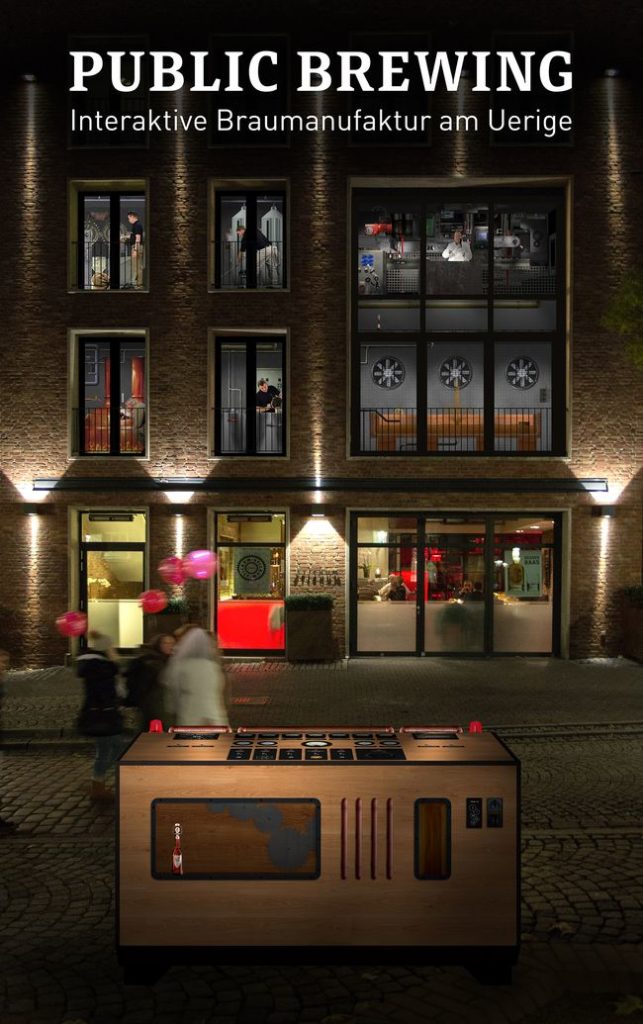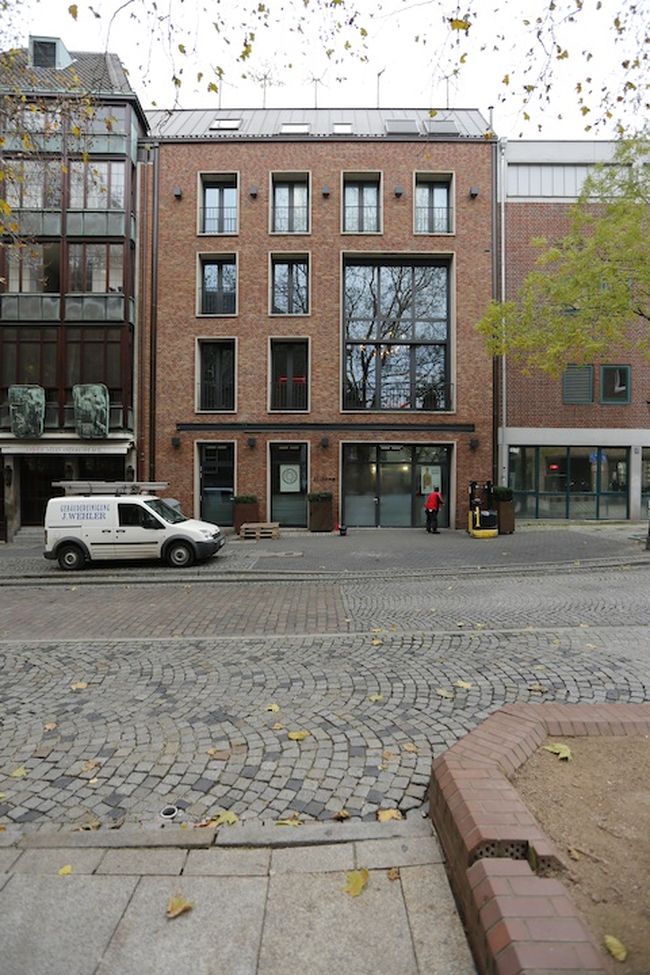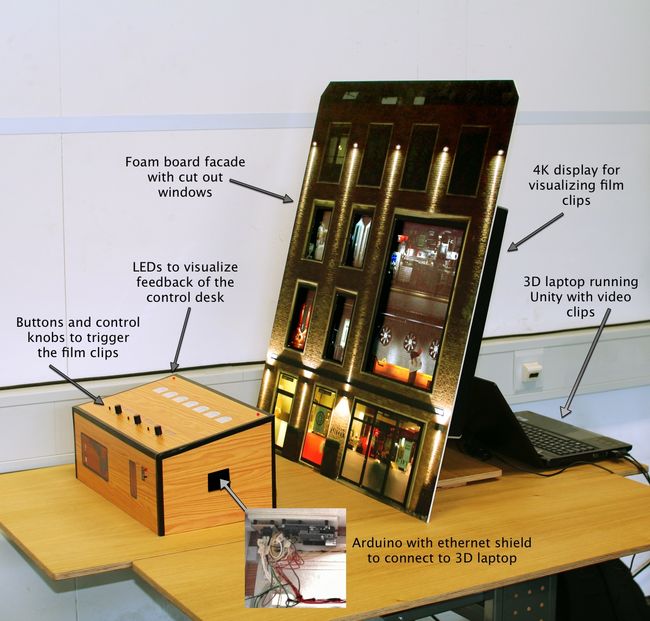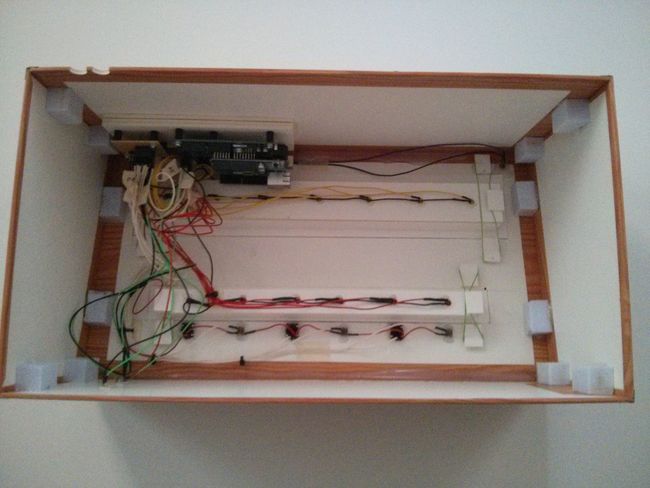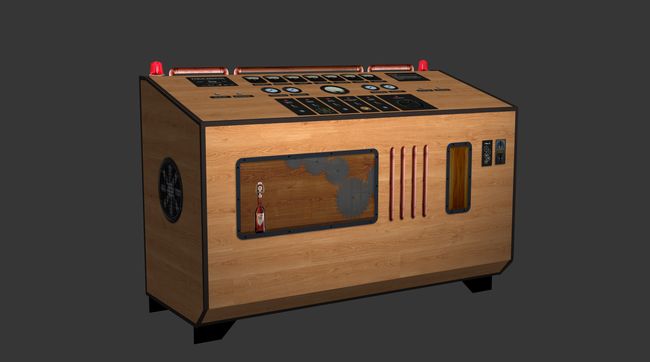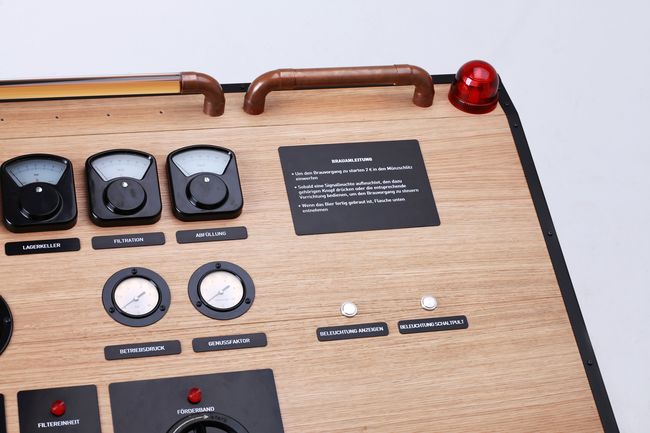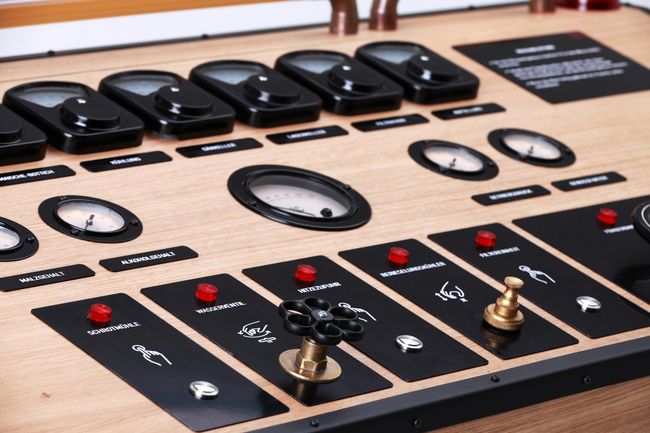
The whole brewing process was visualised including grinding the malt, the fermentation to the point of filling the bottle, using a back projection on the windows of the facade. A control desk in front of the building allowed the visitor to steer the process using buttons, pumps and cranks. Thus the brew is able to make his own beer. The beer comes, after it is virtually bottled, as a real bottle out of the control desk and could be taken away or directly enjoyed. If the control desk is not in use, the brewery employees on the facade ran around bored and signalled the audience that they want to start again. From time to time astonishing scenes are to be seen on the facade. Thus a beer thief runs around or an employee walks drunk through the picture.
The project was developed by Lukas Loss within the scope of his master thesis on the university of applied science in Dusseldorf in a cooperation with the departments of design and media. Besides, he was supported by the house brewery Uerige, a support programme of the innovation alliance North Rhine-Westphalia, Sigma System Audio-Visuell, Furnierholz and Igus.
In contrast to customary media facades the project appeals to all senses. Thus it not only allowed a visual experience, but also acoustic as well as haptic attractions and served at last the taste nerves while trying the “leckeren Dröppkens” as the brewery calls the Old.
This experience was supported by effects in the facade and in the control desk. Thus during the brewing brewing process on the facade beside virtual also real steam rises, which was generated with the help of a nebulous machine in the facade. Different announcements on the switch writing desk provided – according to topical brewing step – information about the respective temperature, pressure and the flow.
Therefore an easy house facade could be transformed into an interactive experience world.
After the successful first public presentation the project was developed steadily and extended by additional functions.
Prototyping
At the beginning of the project several prototypes were developed to test the design and the interactions. The beginning made a prototype out of Foamboard which was pasted with foil in wooden design to receive a fast functioning object for the first tests.
Based on the new findings the second prototype was developed from wood. The first ideas could thereby be concretised. Here it was paid attention to the fact that the interactions are basically so usable as they should be used later also in the right control desk. At the same time this prototype serves by size and weight as a model slightly to be transported to be able to take Public Brewing easily to conferences and faires.
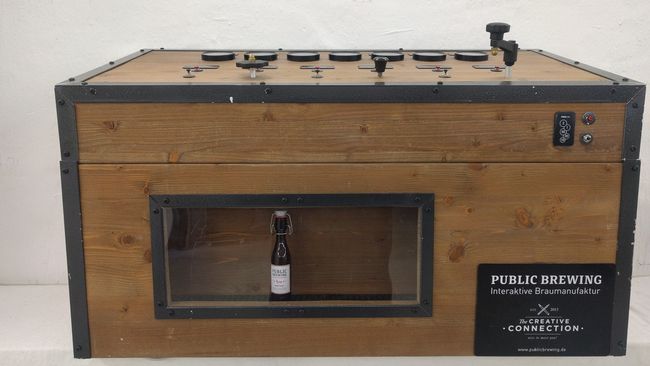
As a result on this base the right control desk was developed.
Augmented Reality Extension Part 1
To allow a more intensive experience and bigger understanding of the processes to the viewer, additional Augmented Reality applications were developed. In the beginning in the form of a magic magnifying glass with which one could look in the control desk to be able to explore the inner life. Herewith one can look in a virtual factory with dwarfs workers who brew the beer and kill time. This was allowed by a Tablet which produced the suitable point of view in the inside of the machine by Edge-Tracking of the control desk. However, in this first step no direct interaction or communication existed between the machine and the AR application. In the second step a one-direction communication followed between the machine and the AR application. If for example, money is thrown into the machine or a button is operated, the interaction is passed on to the AR application. With the throw-in of the money the control of the coins could therefore be pursued. While switching on the lighting the suitable lights are also activated in the AR application. As a result the logical third step was a bidirectional communication between the AR application and the machine. If just no brewing process runs off, any functions of the machine can now be accessed with the Tablet. The pointers of the instruments can be put arbitrarily, lamps can be switched and also now the throw-in of a coin can occur about the AR application.
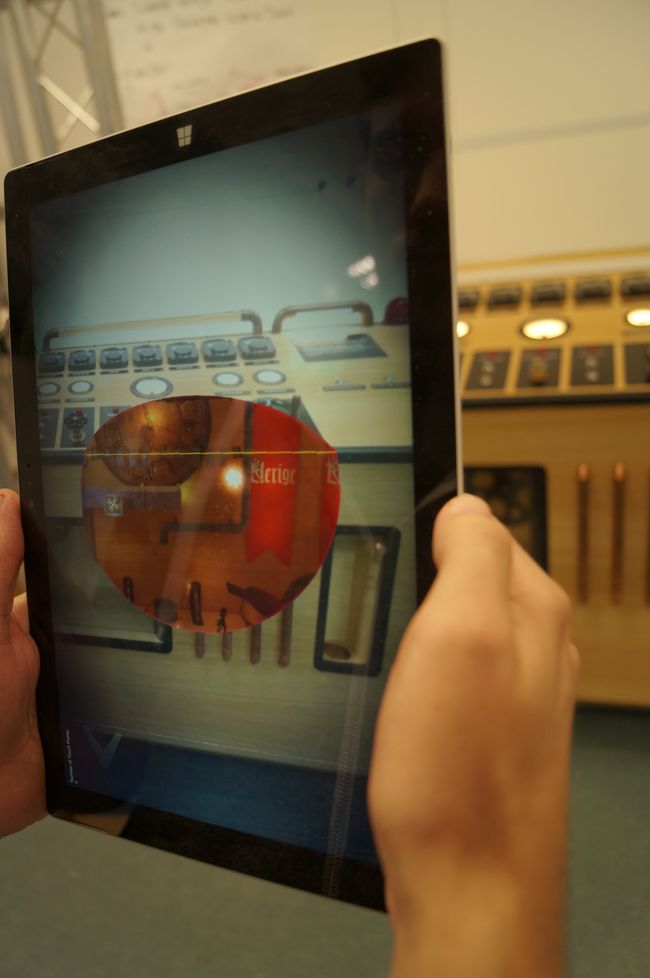
Augmented Reality Extension Part 2
As a result an additional way was pursued. For this purpose a dwarf pushes the bottle about the conveyor belt. For this Cylinder-Tracking and recognition of the label of the bottle is used. Because all bottles are equipped with the same label, the extension can be used with every public Brewing Uerige bottle. The brewing master now can take the experience consequently also with home.
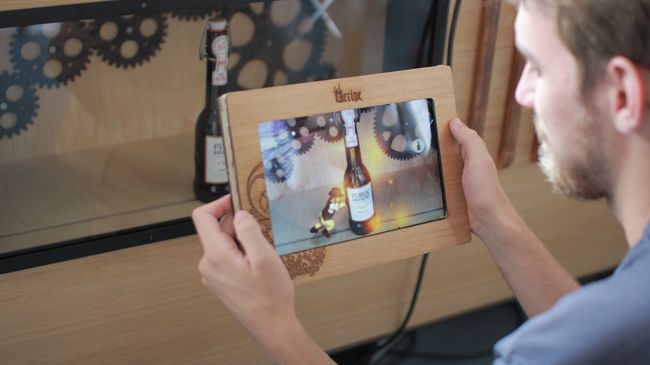
Augmented Reality Extension Part 3
In the third enlargement it is also used Cylinder-Tracking and a recognition of the label to let fly a virtual zeppelin around the bottle. At the same time a message in a bottle which can be opened by a click on the label of the bottle is included in the bottle. This news contains different sayings and rhymes which can be found again in the house brewery on beer mats and on signs on the walls. Interesting in this AR extension is the covering of the virtual contents by the real bottle.
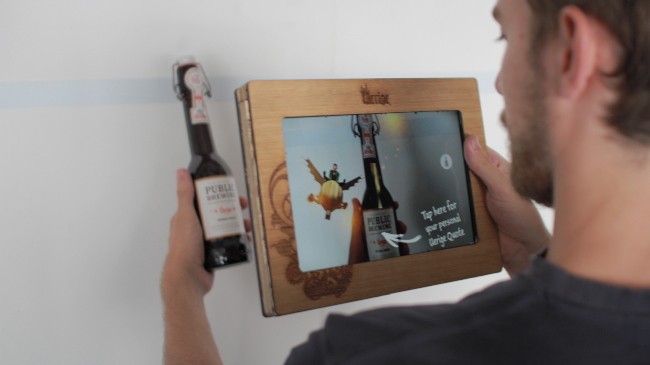
Virtual Reality Extension
After the AR extensions enjoyed big popularity, a VR apllication was developed for the Samsung Gear VR. Now in the style of the AR extension part 1 the direct entry into the world of the dwarfs is possible. For the first time it was introduced to the public at the Heise state on the Cebit in 2016.
Augmented Reality Extension Part 4
Microsoft Hololens uses the topically newest Augmented Reality extension, so that to himself a viewer can allow to explain directly the single steps of the brewing process. For this only one operating element or an announcement of the control desk must be “clicked” to really light up the suitable element and to begin the explicatory video.
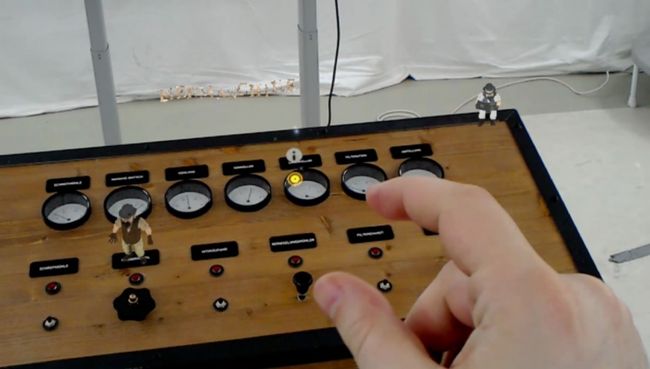
Future Work
In the course of 2018 the control desk is altered to an input device for presentations to be able to use it also in the everyday company.
Involved
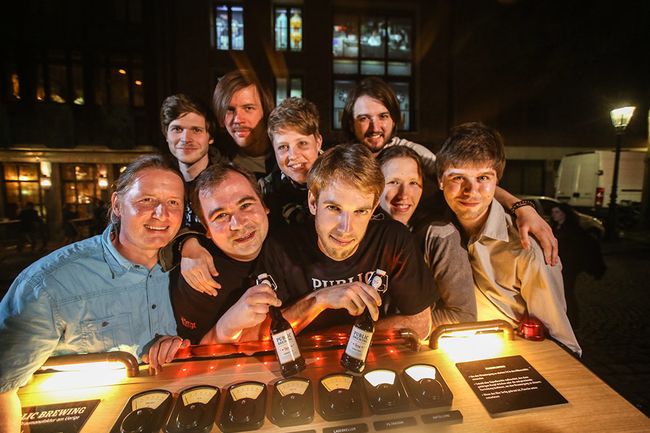
Concept developmnet and project management
Lukas Loss (Bewegtbildhelden)
Project care
Prof. Dr. Christian Geiger
Prof. Dr. Reiner Nachtwey
Anja Vormann
Video production
Lukas Loss
Tom Bechtloff
Stefan Zimmerman
Stephan Kugler
Video editing
Lukas Loss
Roman Tönjes
Sounddesign
Stefan Zimmermann
Control desk construction
Lukas Loss
Tom Bechtloff
Michael Swottke
Electrical engineering
Michael Hogen
Jörn Hornig
Application development
Daniel Drochtert
Photography
Lukas Loss
Roman Tönjes
Melanie Zanin
Videodocumentation / Making of
Stephan Kugler
Lukas Loss
Fairs, Conferences & Awards
- 2015: Red Dot Design Award: Best of the Best
- 2015: ADC Nachwuchswettbewerb
- 2016: Cebit Hannover; Stand der Firma Heise
